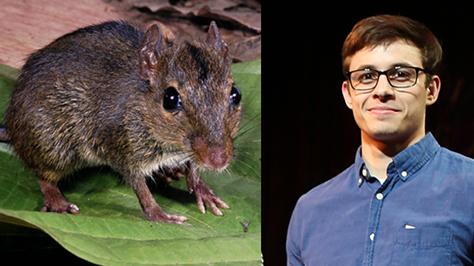Undergraduate research uncovers species living in Ghana
For a long time, a large gap in the African rainforests that spans the west African countries of Togo and Benin was believed to be a dividing line between the long-tailed tree-dwelling rodents in the genera Dephomys and Stochomys.
Then George Bauer did some DNA sequencing work for an undergraduate research project in the Norris Lab at Ohio State Lima and found representatives of a species, Stochomys longicaudatus, living in an unexpected place – Ghana, which is on the wrong side of this large patch of grassy, savanna habitat that creates a gap in the rainforest.

“Forest species are usually found on one side of the Dahomey Gap or another,” said Dr. Ryan Norris, assistant professor of biology. “George’s finding of Stochomys on the ‘wrong side’ of the Dahomey Gap adds to growing suspicions we have had that it may not be as important as previously thought. It’s possible that the region was forested as recently as 120,000 years ago.”
Bauer’s work is included in a new study, “Phylogenetic relationships and biogeography of the Hybomys division (Muridae: Murinae: Arvicanthini), rodents endemic to Africa's rainforests,” which looks at the evolutionary history of a group of striped African forest mice.
The work of Norris, Bauer and their other research collaborators changes our understanding of the evolutionary history of these animals living in the rainforests of Africa and the role that physical barriers like forests and rivers have played in the evolution of the different variations of these rodents.
Norris was able to incorporate both the data and the thought processes expressed in George’s thesis into the final study.
“In his undergraduate thesis, George wrote a quite insightful discussion proposing that populations and species in African forests are initially separated during dry periods when forests retract, but that those separations are maintained by major rivers once the forests expand in wet eras,” Norris said.
Samples for the study came from Sierra Leone south to Gabon and east to Burundi. Norris was on the expeditions to both Sierra Leone and Guinea.
Bauer had just started his first semester of dental school at The Ohio State University when the work that helped him graduate with a research distinction designation on his degree came to fruition. Looking back, he highly recommends that undergrads make the effort to do research, especially if they are considering the next level of education.
“This will bolster your application and challenge you intellectually in a way you would have never thought,” Bauer said. “I felt as though taking on an undergraduate research position was what solidified my seat in dental school.”
For his project, Bauer did DNA extraction from rodent tissue samples and used a polymerase chain reaction technique to make many copies of the DNA of the genes of interest. When the final gene sequencing was complete, he analyzed those sequences to look at the evolutionary history of these animals. The entire process helped develop him in a way other classes wouldn’t.
“Doing undergraduate research is challenging, not in the way that other courses are. It challenges you to think in a way you haven't before. There is no textbook or powerpoint you can rely on that will help show you what the answer is or what it could be,” Bauer said. “Doing research requires you to learn material through primary literature, group discussions and mentorship.”
# # #
Bauer’s sequencing work also contributed to another study: A survey of small mammals in the Volta Region of Ghana with comments on zoogeography and conservation. Adriana Jurich (Biology, 2018) contributed lab work to this project and presented early stages of this research at the Ohio State Lima and Denman Undergraduate Research forums.
Photo credit: Dr. Jan Decher, Curator of Mammals, Museum Koenig, Bonn, Germany
Full citation: Nelish Pradhan, Ryan W. Norris, Jan Decher, Julian Kerbis Peterhans, Christopher R. Gray, George Bauer, Michael D. Carleton, and C. William Kilpatrick "Phylogenetic relationships and biogeography of the Hybomys division (Muridae: Murinae: Arvicanthini), rodents endemic to Africa's rainforests," Journal of Vertebrate Biology 70(2), 21034.1-26, (15 September 2021). https://doi.org/10.25225/jvb.21034
